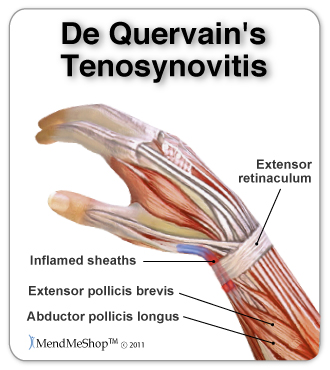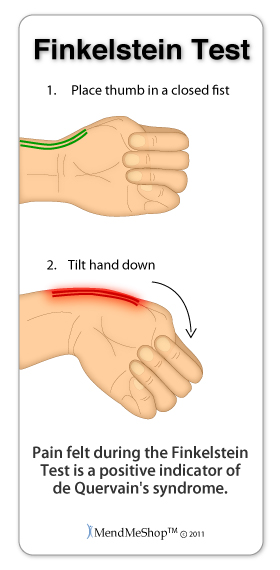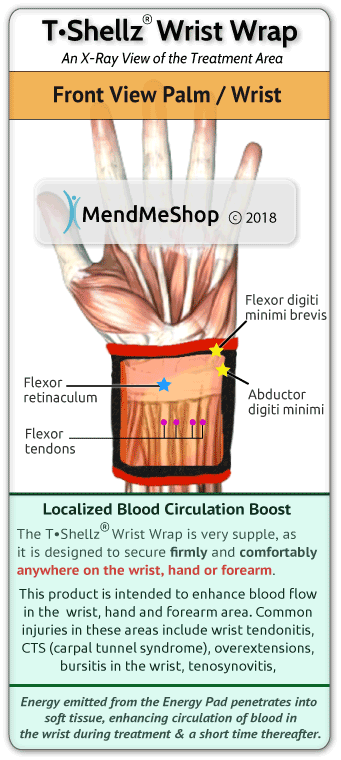If you have contracted De Quervain's Stenosing Tenosynovitis, you will notice a painful irritation below the thumb in the area of the wrist (see image for detail). The tendons that straighten the thumb pass over the back of the wrist and run through a tunnel known as the "first dorsal compartment". It is this area where the pain will manifest itself.
A De Quervians injury means that the lubricating sheath (sheaths help tendons slide with less friction) that lines the tunnel has thickened and swelled. This swelling reduces the available room for the thumb tendon to move. Scar tissue may form between the lining of the sheath and the tendon, further restricting thumb movement.
.
de Quervain's Syndrome is an inflammatory condition that is commonly caused by cumulative injury, and is one of the most common diagnosed conditions treated by hand surgeons. Carpal Tunnel Syndrome - also theorized to be caused by repeated and cumulative trauma, is one of the major causes of lost workdays at the present time. Regarding de Quervain's tenosynovitis, there is potential for symptoms to show elsewhere in the arm other than the area involving the tendon. This can result from the close proximity of the nerves, tendons, sheaths, and fascia of the forearm to the site of inflammation.

The primary symptom of de Quervains tendonitis is pain at the base of the thumb near the wrist. The pain can be sudden and sharp or increase on a gradual basis with use of the thumb or hand. de Quervains is almost always associated with tenderness and swelling of the styloid process of radius bone. Pain can radiate into the forearm and thumb and you may feel a "snapping" sensation when the thumb is moved.
De Quervain's tendonitis was initially common in new mothers who hyper-extended their thumbs while holding the head of their babies. *Further to this, new mothers are particulary susceptible due to hormone related tendon swelling. *Females are ten times more likely to suffer from this condition than males, and occurs most often in individuals between the ages of 30 and 50. Activities that involve movements similar to hammering are suspected of increasing the risk of contracting this condition.
*source: Canberra Hand Centre June, 2019.
de Quervains tenosynovitis is the thickening and inflammation of the sheath containing the tendons of the inner wrist and thumb area (extensor pollicis brevis and abductor pollicis longus tendons). de Quervain's Tendonitis results from inflammation or constriction of the tendons of the muscles of the thumb at the point where they pass into the wrist. In many cases both tenosynovitis and tendonitis occur, a condition known as tendinopathy.
Diagnosis of this condition is based on the location of pain, decreased hand function, and the presence of swelling in the hand.
Surgery is not usually necessary, and is typically the option of last resort. A troublesome complication of surgery for de Quervains tenosynovitis is a painful neuroma of the radial nerve as well as increased presence of scar tissue due to the invasive nature of surgery. Controlled exercise several times daily is commonly recommended, especially to prevent frozen shoulder, after the acute inflammation is controlled. Injection within the tendon sheath of a corticosteroid is also sometimes very helpful.
A physician/surgeon will typically start to consider surgery for de Quervains Syndrome if the condition persists after conservative treatment options have been tried for at least 3 months. In most cases, the surgery for de quervain's tenosynovitis is "day surgery", meaning you will most likely not be kept overnight in the hospital after surgery.
Surgery is typically performed using a local anaesthetic with sedation. A small incision is made and the compartment confining the tendon is divided. Once surgery is complete, you will most likely be required to wear a splint for a couple weeks and then undergo stretching/strengthening with the physical therapist later.The wrist will continue to be inflamed until you allow it to rest from the pain causing activity. Continued damage will cause chronic inflammation, secondary adhesion and general degeneration of the tendon. The tendon sheath itself will probably be injured as the tendon swells, increasing the pain of the condition. When treating the wrist tendon(s), rest the area, apply cold compression for 10-20 minutes at a time for at least 3 times a day. Do this to the injured area for the first day to 3 days of inflammation or longer until the swelling calms down.
If you have tendinitis in your hand or wrist, rest is highly recommended. Avoid activities that cause pain or may have caused the inflammation and begin cold compression treatments as soon as possible.
During the healing process, scar tissue builds on the damaged tendons; this scar tissue can cause the tendon to thicken, decreasing the area in tight spaces (such as the wrist), increasing the chance of nerve impingement. Nerve impingement in the wrist is basically what Carpal Tunnel Syndrome describes.

In addition, know that scar tissue attaches to everything. It can bind tendons, ligaments, muscles, bone and even skin together wherever it grows. Inflexible scar tissue will limit movement of your soft tissue very quickly. Tendons and muscles that were once elastic are now constrained - if you stretch it too far it will start to rip, causing spikes of pain. As a result, movement of the entire joint is limited, making it difficult to flex your hand and/or wrist or even grasp objects. At the very least, scar tissue leaves a tendon weaker than a healthy tendon, leaving injury at greater risk of further deterioration and possible tearing.
The trick to any tendon injury is getting it to heal with minimal scar tissue formation and with as much realignment of tendon fibers as possible. To achieve this, your doctor will most likely recommend up to 6 months of conservative treatments. Even with optimum healing there is always less elasticity in a previously injured tendon. The trick is to make sure you heal it the best you can, that way your chance of re-injury down the road is much lower than average - which is well over 50%.
Once the inflammation of your tendinitis has been reduced through use of a Cold Compress or Ice Pack, nourishing and strengthening of the hand/wrist tendons, muscles and surrounding area is recommended - this includes our recommendation of stretching and home treatments using the Wrist TShellz Wrap®. Talk to your doctor or medical professional to find out which exercises are appropriate for your situation.
The Wrist TShellz Wrap® may be used after the acute swelling has improved; the TShellz Wrap® will stimulate blood flow in the local area, while also warming up the tissue. It is known that warmed tissue will experience a larger range of motion and increased extensibility and this is exactly what you want when you are trying to recover from a soft tissue injury. Increased extensibility and flexibilty in soft tissue means it is less likely to strain or tear further during activity, and less re-injury during this period means less setbacks during healing. Less re-injury helps minimize the build up of scar tissue around the tendon during the healing process, while also reducing the risk and severity of overcompensation pain and secondary injuries. Basically, the value of a faster recovery is often underestimated, as the impact of chronic injuries can quickly spiral out of control.
Often when a tendon injury occurs, the injured area is rested a bit, a pain killer is taken and we continue on with our normal activities. If the strain was minor, the body may be able to heal the tendon fibers normally. Unfortunately, this is not the usual result because the injured tendon is being used instead of rested. Because of the stress on the tendon, the body heals the injured fibers by binding them together with fibrotic adhesions or scar tissue. This is done in an attempt to prevent further damage to the injured area. It is a normal protective response of the body, but buildup of scar tissue can and does become a big problem over the long term.
Scar tissue buildup is one of the main reasons we advocate the use of a TShellz Wrap® over the long term once the swelling is down. Much of the pain may have disappeared with the swelling, but that does not mean your tendonitis has healed. The trick is to continue boosting blood flow to the area on a daily basis, helping keep tissues in the area flexible and less likely to strain while your tendon(s) continue to build up strength.

Conservative treatment tools just like these have been used successfully by thousands of soft tissue injury sufferers - just like you.
We believe the use of TShellz® Circulatory Boost Wraps for boosting blood flow to soft tissue in the area of application is one of the most under-utilized home treatment options available on the market today. We have client after client that have tried many options out there and have been amazed at how effective and fast the TShellz Wrap treatment can relieve pain and increase blood flow in the treatment area.
These tools are what you need for rapid healing. These are the tools that top professional athletes use to treat their injuries every single day. And just like these athletes, you can treat yourself at home. If you are suffering from any form of tendinopathy or you're recovering from soft tissue surgery, you can heal quickly if you treat your injury correctly. That means using the right therapies every single day.
With regular use of the TShellz® Circulatory Boost Wrap:
*Know that every personal soft tissue injury is unique and the TShellz Wrap may not work for everyone. This is why we offer a 60-day money back return on all our TShellz Wrap devices.
We believe the use of TShellz Wraps® for boosting blood flow to in the area of application is one of the most under-utilized home treatment options available on the market today. We have client after client that have tried many options out there and have been amazed at how effective and fast the TShellz Wrap treatment can relieve pain and increase blood flow in the treatment area.
With regular use of the TShellz Wrap:
*Know that every personal soft tissue injury is unique and the TShellz Wrap may not work for everyone. This is why we offer a 60-day money back return on all our TShellz Wrap devices.
Product Advisors are available 9:00 am to 5:00 pm Eastern Standard Time Monday to Friday.
I want to learn more about Post-Surgery Recovery
I want to learn more about TShellz Wrap® Circulatory Boost
I want to learn more about Ice & Heat: Which Is Better For Treatment?
I want to learn more about Tendonitis Treatments
I want to learn more about Tendonitis Surgery
During your recovery, you will probably have to modify and/or eliminate any activities that cause pain or discomfort at the location of your soft tissue injury until the pain and inflammation settle. The more diligent you are with your treatment and rehabilitation, the faster you will see successful results!
Please be aware that this information is neither intended nor implied to be a substitute for professional medical advice. CALL YOUR HEALTHCARE PROVIDER IMMEDIATELY IF YOU THINK YOU MAY HAVE A MEDICAL EMERGENCY. Always seek the advice of your physician or other qualified health provider before using any of our outstanding products to make sure they are right for you and your condition or if you have any questions regarding a medical condition. Always see your doctor for a proper diagnosis as there are often many injuries and conditions (some very serious) that could be the cause of your pain.
© 2025 In.Genu Design Group, Inc. Contact Us